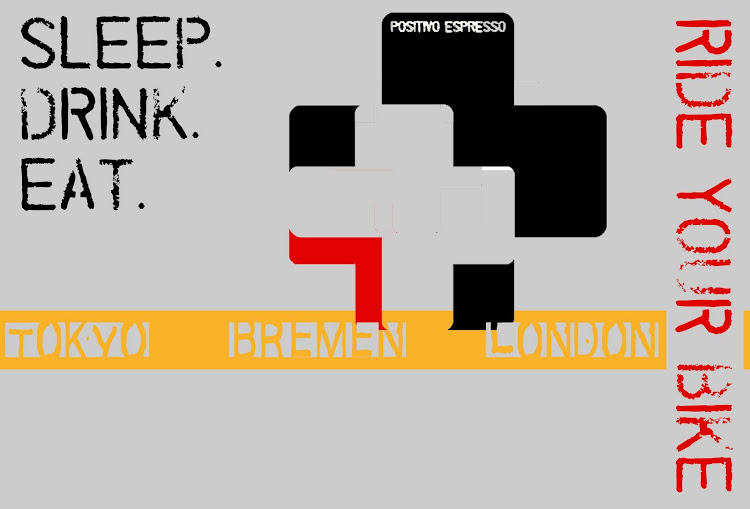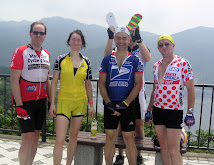At my UBI frame-building class, we learned the basics of why almost all bikes have fairly similar geometry (or "virtual geometry" in the case of compact-style frames), at least within their class -- road, MTB, cyclocross, BMX, hybrid, etc., etc. As a frame builder, you can experiment with changes ... but will usually quickly find out why your novel geometry just does not work for its intended purpose.
So for the Yamabushi, I followed the traditional geometry pretty carefully, starting with frame measurements from my last two road bikes, and adjusting for a cyclocross build -- with slightly longer chain stays, 425mm instead of 405-410mms, and allowing for a longer fork.
I built up the bike with a Ritchey cyclocross fork, which has a vertical measurement of 391mm from the fork crown to the axle, and an offset (rake) of 45mm. This is a bit short for a cyclocross fork (they range 390-410mm), but noticeably longer than a standard road fork of 365-375mm. The extra length allows for fatter tires and mud clearance, of course. Anyway, the Ritchey works perfectly, and the result is a bike that is comfortable to ride and handles well. The Yamabushi is not as nimble as, say, my 2007 Cervelo R3-SL was, but it is stable, and it responds well, going just where I point it, when I point it.
Last weekend I put on the bike a new fork with disk brake mount, attached the new Avid BB-7 disk brake and my recently built wheel with a disk rotor. I added "The Plug II" (USB charger off the dynamo hub), and was excited to find that everything seemed to work.
I went out for a spin.
The brake is great -- much more control, and better stopping power, than the V-brakes I have been using. The new front wheel with 50mm carbon clincher rim feels very fast. The Schwalbe Ultremo 700x28 tires roll fast and are very comfortable with the extra air volume -- perfect for a Brevet that will go over good quality roads.
But the bike seemed to steer oddly. It felt as if I was steering a boat, with a very little rudder pushing against a strong current. At first, I thought something was wrong with the headset or the fork installation -- too tight, or too loose? Or maybe the disk brake cable was gumming up the steering? After eliminating these choices, I decided to compare the new fork with the one I had removed.
 |
| Left side -- a fork too long. |
The feeling was odd. Very odd. Size does matter. And shape.
I will try again with another fork as soon as it arrives.
-----------------------------
UPDATE: I got the new fork, which has the same rake as the Ritchey (45mm) and is in between the two in length 400mm). The handling is no longer boat-like. The wheel seems very fast and the disk brake very nice. The steering is more Cadillac than Porsche, but that seems very stable, and fine for most uses. Tomorrow I will ride it to work and if all is well, give it a real test the coming weekend.
UPDATE2: As an experiment, I switched back to 700x35 cyclocross tires (Continental "Speed" version -- for hard packed dirt and pavement, roll reasonably well) from the 700x28 slicks I had tried before. This increases the effective diameter of the wheel and this the "trail" of the wheel's contact point a bit more, and the handling shifts from Cadillac in the direction of Porsche. It is a bit odd that fatter tires with more tread result in nimbler handling ... but that is so.
Still, the cyclocross tires definitely roll slower than normal road tires. I ordered some 700x30 Grand Bois touring tires that randonneurs seem to rave about (distributed in the U.S. by the rider who completed Cascade 1200 with the fastest time this year ... so they may be fat, but they're not slow!)
UPDATE3: I noticed that the FSA headset I have had on the Yamabushi (used, removed from frame I rode 2001-2006) was noticeably gummed up. Some lubricant helped a bit, but still the steering seemed a bit resistant. Maybe this was at least a contributing factor to the "boat" feeling. In any event, I put on a new Cane Creek headset I ordered last month. Yes, I have a headset press and a removal tool,which have now pretty much paid for themselves by getting their first use! With the new headset and the Grand Bois tires, the front end us very responsive, slightly toward the "twitchy" end of the spectrum. But when I put an Ortlieb handlebar bag off the front, the handling seems really perfect -- as close as possible to "neutral". I will ride this combination on a cold 400km Brevet tomorrow.
UPDATE4 (February 3): I have now used the disk brake and 400mm fork on the 400km Brevet, and since for almost 3 weeks of commuting and riding in the city. I have come to the conclusion that the bike handling issues I had were at least significantly the result of the gummed up, very old FSA headset. The bike handling has been just fine with the new headset, with any of 3 sets of tires, with or without a handlebar bag. If I get some extra time, I might even try swapping back in the 410mm/more rake fork just to see if it is more rideable now with the new headset ... but no time right now.











9 comments:
I am not as experienced, or ambitious, but I have changed a fork on a road bike and made sure to get as many of the dimensions the same as possible. Worked. Rides great. I can see why you'd run in to trouble though. My fork posts are here, if interested: http://hanlonsrzr.blogspot.jp/search?q=fork
It is no surprise that it will become harder to steer a bike when the rake becomes longer. Think Peter Fonda/Dennis Hopper andn their bikes. The surprise however is, that such small, incremntal changes have such a big impact on the steering. Wow.
Yes, a bike with too long a front fork and too much rake is like Peter Fonda riding a chopper motorcycle in Easy Rider. Very stable at high speed, but devilish to maneuver when going slowly.
I ordered via Nashbar another low-end carbon cyclocross fork with disk brake mounts that has less rake and length than the one I got from GS Astuto (Tim has said he will take back the fork I got from him, even though I cut the crown down some when I installed it).
I have a mechanical disk brake too, but don't really like it that much. It is noisy, weak and finicky to align the pads and rotor. To get good stopping power it seems the pads have to be rubbing continuously.
What size chainrings and what front derailleur do you have on your Yamabushi? Did the big ring touch the stay at first. Drop or flat bars? How far is the outer chain ring from the center of the seat tube? How wide is the BB shell?
I'm trying to build a bike now.
Hi CM:
The mechanical disk brake is an Avid BB-7. I want to try the disk with a carbon clincher and not need to worry about overheating rims/heat flats, poor braking, seizing etc. on longer descents. Hope it works.
I am using a SRAM Rival groupset with their cyclocross crankset (46-36 rings, GXP style BB cups with English-68mm-bottom bracket shell, 172.5mm cranks). There is enough clearance between the rings and the chainstays so that I can use 53-39 rings.
When I built the frame, of course, I did a full (1:1) scale drawing and measured all of this when figuring out what size, orientation and placement would work for welding the chainstays to the BB shell. My drawing is sitting in a closet in my mom's house in the U.S., so forgive me if I cannot give you the exact measurements.
Doing your own accurate drawing is the only way to get this right, since you won't want make all the same choices as I did. In the worst case you can get someone to help you put a big dimple in your right chainstay ... though I'm glad I did not need to try that.
Did you cut,machine and filet braze, steel I assume, all the tubes yourself? I'm impressed.
How wide a rear tire do you have clearance for?
Is the amount of cable pull different between the disk and V-brake? The SRAM Rival cyclocross levers are designed for either I guess?
CM:
TIG welded, not fillet brazed.
Lots and lots of rear tire and/or fender clearance.
No cable pull issues with using SRAM Rival (road) brifters with a disk brake.
Just search online (or ask Tim Smith at GS Astuto if you are in Tokyo) to get answers to your questions.
See also:
www.bikeschool.com
http://positivo-espresso.blogspot.jp/2012/02/it-is-done.html
http://positivo-espresso.blogspot.jp/2012/02/it-is-starting-to-look-like-bicycle.html
http://4.bp.blogspot.com/-YMVQzyROTiI/T4v_ipNoUFI/AAAAAAAADec/b1oKV0fgm3A/s1600/IMG_1417.JPG
I have updated the post to reflect my impressions of the bike handling with the new fork, and a different sized tire.
Post a Comment